
Lehigh Valley Zoo Education Department – Hello there, my name is Natasha and I was a spring Conservation Education Intern and soon to be full-time summer intern at the Lehigh Valley Zoo. My background is in studying biology and I have been lucky to do lots of cool wildlife research so far. I just spent the last couple years post-graduation collecting data for research projects on chimpanzees and orangutans! Now, before I go back to graduate school in the fall I am excited to be interning with the Education Department at the zoo. And I would recommend it for any fellow field researchers and wildlife biologists!
Why? Because during my time within field research, I have traveled to many places to see amazing species at the cost of spending a long time isolated in remote areas. Really with no way to effectively communicate my passion for wildlife conservation and studying the natural world to others. And the people I spent all this time with were people of similar interests and science backgrounds as me. Now, at the Lehigh Valley Zoo, I can speak to people outside of this small bubble about wildlife from all around the world and species native to PA!
 As a conservation education intern, I connect people directly to the animals and give them a personal experience. All while educating about wildlife behavior, biology, and ecology. Through my studies, I learned to create very direct and factual presentations. I spoke only in scientific terms. What I haven’t learned is how to be fun, engaging, and spontaneous in how I communicate to a general audience. It’s one thing to give a structured PowerPoint presentation about research and a whole other to hold on animal in my hands, just talking to people about what makes it so cool. I have learned so much from watching our awesome Educators give animal ambassador presentations that can inspire, inform, and entertain all at the same time. I’m excited to do this as well!
As a conservation education intern, I connect people directly to the animals and give them a personal experience. All while educating about wildlife behavior, biology, and ecology. Through my studies, I learned to create very direct and factual presentations. I spoke only in scientific terms. What I haven’t learned is how to be fun, engaging, and spontaneous in how I communicate to a general audience. It’s one thing to give a structured PowerPoint presentation about research and a whole other to hold on animal in my hands, just talking to people about what makes it so cool. I have learned so much from watching our awesome Educators give animal ambassador presentations that can inspire, inform, and entertain all at the same time. I’m excited to do this as well!
 There’s no feeling quite like when a family genuinely thanks me for teaching them about an animal. It’s so rewarding to watch kids and adults alike be mesmerized by the animals and asking questions, eager to learn more. Most people are not as fortunate as I have been to see these species in the wild. Many don’t have access to natural spaces in their backyards. That’s why the Lehigh Valley Zoo is so important. The zoo also always spreads great conservation messages, something very important to me. By having ambassador animals of endangered species and participating in Species Survival Plans they contribute to wildlife conservation every day, which is very cool!
There’s no feeling quite like when a family genuinely thanks me for teaching them about an animal. It’s so rewarding to watch kids and adults alike be mesmerized by the animals and asking questions, eager to learn more. Most people are not as fortunate as I have been to see these species in the wild. Many don’t have access to natural spaces in their backyards. That’s why the Lehigh Valley Zoo is so important. The zoo also always spreads great conservation messages, something very important to me. By having ambassador animals of endangered species and participating in Species Survival Plans they contribute to wildlife conservation every day, which is very cool!
 Being at the zoo also makes me a better naturalist in my own hometown. I learn about the wildlife and ecology of where I live and then spread this knowledge on to others through presenting PA native animal ambassadors and through nature hikes in Trexler Preserve. I also get to truly test out my understanding of an animal’s biology through creating enrichment items: things that can stimulate the animal’s primary senses and encourage natural behaviors.
Being at the zoo also makes me a better naturalist in my own hometown. I learn about the wildlife and ecology of where I live and then spread this knowledge on to others through presenting PA native animal ambassadors and through nature hikes in Trexler Preserve. I also get to truly test out my understanding of an animal’s biology through creating enrichment items: things that can stimulate the animal’s primary senses and encourage natural behaviors.
 I am so excited for the summer: to start doing outreach programs and animal presentations for bigger audiences. Plus, I hope to share my stories of seeing these animals out in the wild during my research days! I can show people what a field biologist really does by sharing my experiences. If you come to visit the Lehigh Valley Zoo this summer, you might just here me talk about approaching wild zebras on foot to study a thing call flight initiation distance while we stop by the zebras on a zoo tour. Or hear my story about being stranded on a penguin island during one of our daily feeding talks of our African Black-footed Penguins! My goal this summer is to connect people, science, and wildlife conservation together each day!
I am so excited for the summer: to start doing outreach programs and animal presentations for bigger audiences. Plus, I hope to share my stories of seeing these animals out in the wild during my research days! I can show people what a field biologist really does by sharing my experiences. If you come to visit the Lehigh Valley Zoo this summer, you might just here me talk about approaching wild zebras on foot to study a thing call flight initiation distance while we stop by the zebras on a zoo tour. Or hear my story about being stranded on a penguin island during one of our daily feeding talks of our African Black-footed Penguins! My goal this summer is to connect people, science, and wildlife conservation together each day!
Written by Natasha Bartolotta
Conservation Education Intern
Lehigh Valley Zoo | Schnecksville, PA
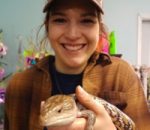
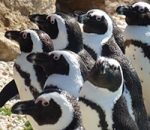
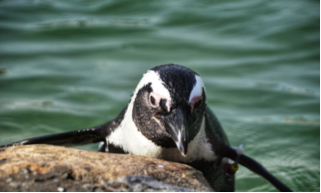 What Kind of Habitat do African Black-footed Penguins Have in the Wild?
What Kind of Habitat do African Black-footed Penguins Have in the Wild?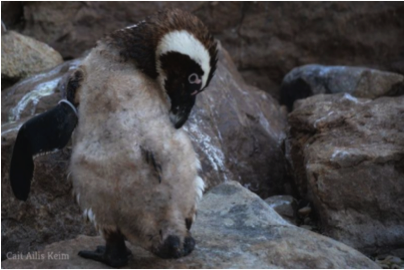 As a year progresses, penguins will begin to look fairly drab. That is because their feathers become old and brittle as time goes on. Once every year, a penguin will go through their catastrophic molt, which means that they lose all of those old feathers all at once. The molt typically takes about two weeks from start to finish, and as soon as all the old feathers are shed, they grow in beautiful, shiny new feathers.
As a year progresses, penguins will begin to look fairly drab. That is because their feathers become old and brittle as time goes on. Once every year, a penguin will go through their catastrophic molt, which means that they lose all of those old feathers all at once. The molt typically takes about two weeks from start to finish, and as soon as all the old feathers are shed, they grow in beautiful, shiny new feathers.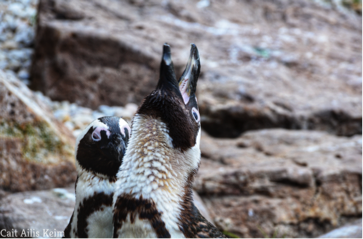 Noisy Neighbors
Noisy Neighbors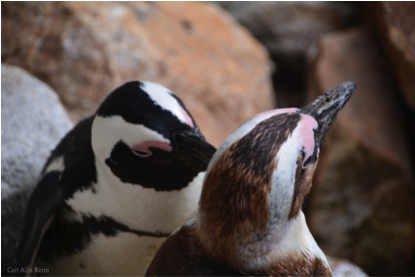 Penguin Parents
Penguin Parents